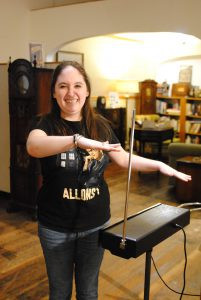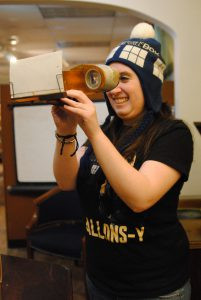Doctor Who, a science fiction television program celebrated for its longevity spanning over five decades, is instantly recognizable not only for its time-traveling adventures but also for its equally iconic theme song. This haunting and unforgettable melody has a history as intriguing and transformative as the Doctor himself, undergoing numerous iterations since its inception in 1963.
 Amy Mulligan, a Doctor Who enthusiast and Spark Museum volunteer, demonstrates the theremin while wearing a Doctor Who t-shirt, highlighting the early electronic music technology that influenced the Doctor Who theme song.
Amy Mulligan, a Doctor Who enthusiast and Spark Museum volunteer, demonstrates the theremin while wearing a Doctor Who t-shirt, highlighting the early electronic music technology that influenced the Doctor Who theme song.
The original composition of the Doctor Who theme is credited to Ron Grainer. However, it was the groundbreaking work of Delia Derbyshire at the BBC Radiophonic Workshop that truly brought the score to life and cemented its place in television history. Grainer’s score was then entrusted to Derbyshire, a sound synthesist renowned for her pioneering approach to electronic music. At the Radiophonic Workshop, Derbyshire masterfully transformed Grainer’s notes into the electronic masterpiece we recognize today. Her expertise in manipulating sound electronically allowed her to create melodies that were remarkably ahead of their time. While electronic instruments like the Theremin had existed since the 1920s and were championed by artists like Clara Rockmore, Derbyshire’s arrangement for Doctor Who pushed the boundaries of electronic music in television.
What sets Derbyshire’s original rendition apart is the incredibly inventive method she employed to produce it. Astonishingly, the Doctor Who Theme Song was created before the widespread availability of even basic analog synthesizers. The theme’s signature elements – the pulsating four-count bassline, the ethereal “swooshing” sounds, and the chilling, gliding melody – were all meticulously crafted through the manipulation of analog tape. Derbyshire and the technicians at the Radiophonic Workshop utilized white noise, plucked strings, and manipulated oscillators and “wobulators” to generate the individual notes and sonic textures. These sounds were then painstakingly spliced together and manipulated – sped up, slowed down, and layered – to construct what would become the musical score. Lacking even a two-track player, the team had to assemble the theme in segments. Once these components were prepared, the final tracks were recorded onto three separate tapes, requiring precise synchronization to combine them perfectly. This intricate and time-consuming process, though demanding, was instrumental in forging a truly unique and unforgettable sound.
 Delia Derbyshire, the pioneering sound synthesist at the BBC Radiophonic Workshop, who ingeniously realized the iconic Doctor Who theme song using tape manipulation techniques in the 1960s.
Delia Derbyshire, the pioneering sound synthesist at the BBC Radiophonic Workshop, who ingeniously realized the iconic Doctor Who theme song using tape manipulation techniques in the 1960s.
The story of the Doctor Who theme song is a testament to innovation, a principle celebrated at institutions like Spark. In the early 1960s, the BBC Radiophonic Workshop was a department struggling with limited funding and outdated equipment, often relying on discarded materials from other departments. Despite these constraints, the team, spearheaded by Derbyshire, achieved the extraordinary: they created one of the most recognizable and influential television themes in history, simultaneously pushing the boundaries of electronic music. Derbyshire and the Workshop essentially laid the groundwork for electronic music in the latter half of the 20th century, achieving this with remarkably limited resources.
Delia Derbyshire, who passed away in 2001, held degrees in both music and mathematics, embodying a rare blend of artistic and scientific talent. Her legacy is profoundly inspirational, demonstrating how the fusion of science and art can revolutionize music and sound design. Celebrating her 80th birthday on May 5th serves as a reminder of Derbyshire’s enduring impact as a pioneering woman in both the arts and sciences, an unsung hero whose innovative spirit continues to resonate. The eerie and captivating Doctor Who theme song stands as a lasting monument to her ingenuity and the boundless creativity that can flourish even within limitations.
